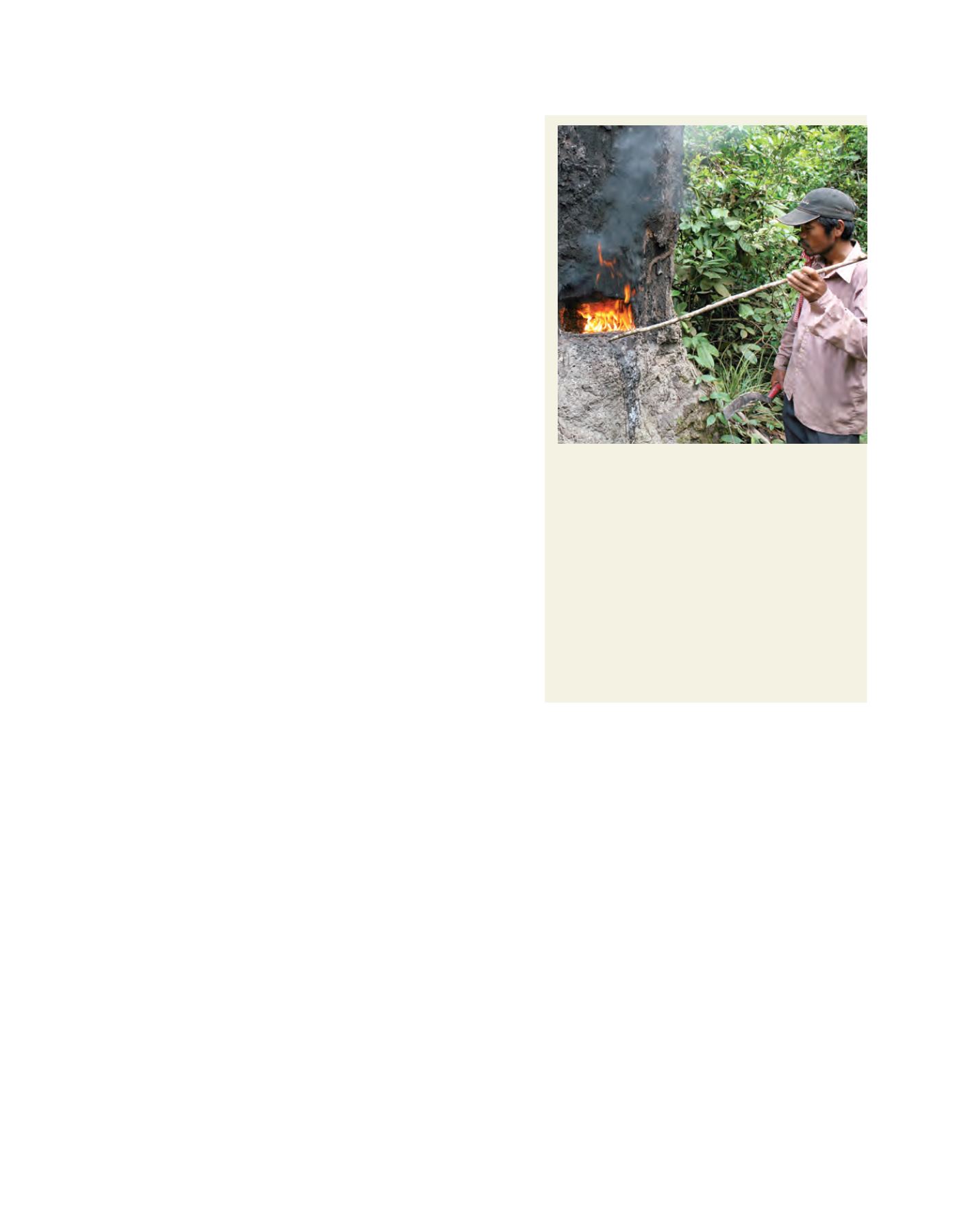

[
] 220
the local people also report illegal activities to me which is very
helpful since I have a large area to patrol.”
Over the course of four years, the Capacity-building for Sustainable
Forest and Land Management Project delivered a massive grass-
roots training programme through 70 field-level training sessions
on community forestry. Beginning with 33 nationals who became
community forestry trainers, a further 1,416 individuals were trained
to understand the process and benefits of the community forests
programme, the most important being secure rights over forest lands.
Once the long procedure for legal recognition was over, the next
step was learning to manage the forest lands. Through other livelihood
support programmes, local administration officials and communities
were also taught to develop sustainable forest management plans.
Rebuilding livelihoods
For Ms Chea Tun, a mother of seven, life in Kbal O KraNhak has
changed from an uncertain struggle for survival to an assured harvest
of rice and soya beans in addition to the cassava that she grows
upland. “I know the agreement was signed, and I feel more secure
that I can use forest materials, like firewood, mushrooms, vines to
make fences, and resin,” she says. “Some members of the community
collect resin. If I want a bit, they give it to me for free. We mix it with
bark and use it as fuel to light the stove.”
Having realized the economic value of their forest land once more,
the community is determined to protect it. “We used to talk about
how to stop locals and outsiders from cutting down trees,” says
Chea Thun, “but there was nothing we could do to stop them. We
have more power now that we signed the community forest agree-
ment. This year, an outsider was cutting down trees illegally. We
tracked him down and confiscated his materials. Then we reported
it to the Forestry Administration.”
In Kampong Thom, as in other areas, the programme is also
encouraging women to take an active part in the drawing up of
Forest Management Plans. The Manage our Forests project is active
in Kampong Thom and Kratié provinces and is helping 21 villages
create and implement management plans for 20 community forests.
Community forestry training is a key function of these projects.
During 2009-2010, the three projects hosted 54 field training events
and involved 1,339 participants from the Forestry Administration,
Government agencies, NGOs and local community forestry groups.
Ms. Sao Saveun, for instance, took over her husband’s elected seat on
the committee and is actively involved in management, inventory,
and patrolling of forest areas.
Mua Amkon, a community forest member from Boengkok village
in Kampong Chhnang sums up their common narrative: “When I
was young, this whole village was forest land. Only a few families
lived here. We used the forest for building a few small houses, for
cow sheds and for collecting firewood. During the Pol Pot regime,
the forest was cleared to make a coconut plantation. Starting from
around 1980, more and more people moved in and needed farm-
land, so they cleared the forest, and it disappeared. I really regretted
seeing the forest disappear. We used to have a lot of trees, and then,
almost nothing was left. But now, we can protect the forest. We are
lucky to have the opportunity.”
In 2010 Beongkok village joined the ranks of legally recognized
community forests in Cambodia. In that same year, the National
Forest Policy (NFP) for 2010-2030 was approved, paving the way
for legal and policy reforms in the forestry sector. In recognition
of forests’ essential contribution to national development, the
NFP emphasizes the importance of good governance
and promotes community forestry specifically under
Programme 4 of its six-point programme. Indeed the
strategic direction for Objective 8 states community
forests have ‘demonstrated considerable potential to
protect forests and support rural livelihoods. Recently
community forestry has expanded from low value
forest to also include more valuable forest’.
RECFOTC continues to engage not only in formali-
sation of community forests but also in community
forest networking, management plans and enhance-
ment of rural livelihoods. Through a ‘programmatic
and partnership’ approach, it hopes to contrib-
ute significantly to the achievement of the goals
and targets of the Community Forestry Program of
National Forest Program (2010-2029) endorsed by
the Royal Government of Cambodia in October 2010.
Together with the Spanish Agency for International
Cooperation and Development and the European
Union, RECOFTC has also expanded its coverage to
some 200 community forests in ten of 24 provinces in
the country. And yes, that’s more good news for the
villagers of Kampong Thom.
Mr Teav Pot collects resin from a
dipterocarp tree
. He can
sell the resin for 30 cents a kilo or trade it for rice. Resin is
a primary non-timber forest product for the community, used
for sealing furniture, making soap, and fuelling lamps and
stoves. Although the process looks harmful to the tree, resin
can be collected sustainably. A small cut is normally made
in the tree, and heat from a small fire causes the resin to
flow. Studies in southern Mondulkiri province reported that
86 per cent of families owned resin trees, with an average
of 77 trees per family. The income from the sale of resin
averaged US$3.6 per tree per year (with a mean annual
income per family ranging from US$299-377 across four
villages). The total annual income from resin sales across
the four villages was US$61,000.
6
Of the 11,000-18,000
tons of resin collected in Cambodia each year, approximately
3,000-4,000 tons is sold domestically and the remainder is
exported to Viet Nam, Thailand and Lao PDR.
Image and interview: Alison Rohrs, RECOFTC
















